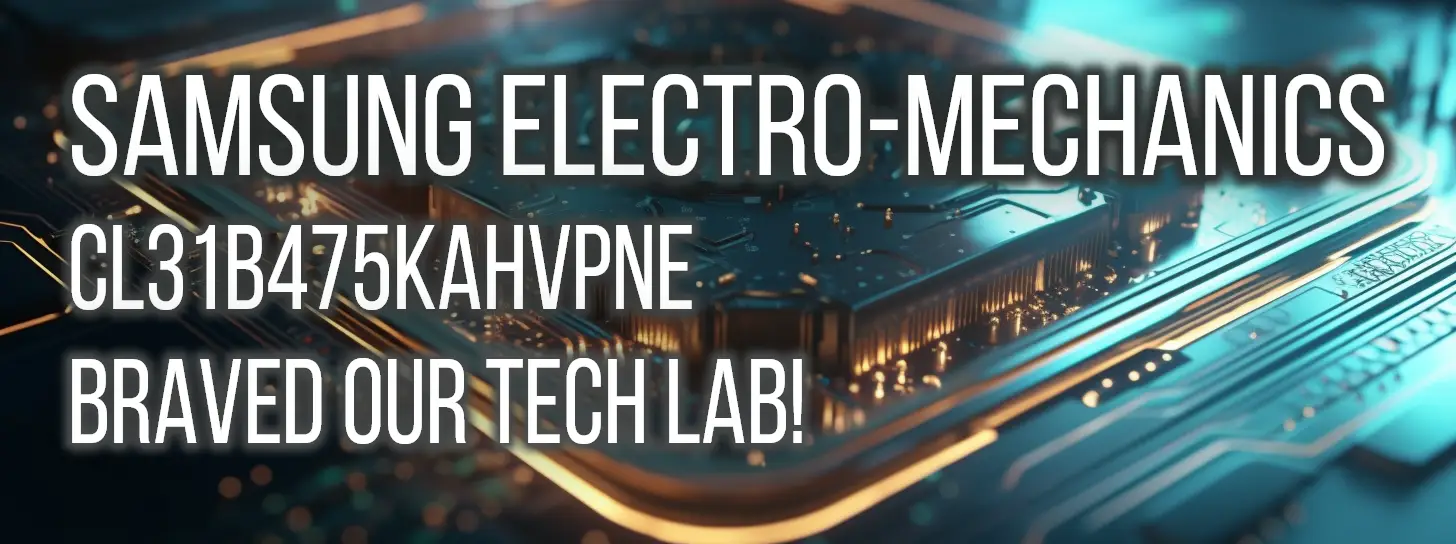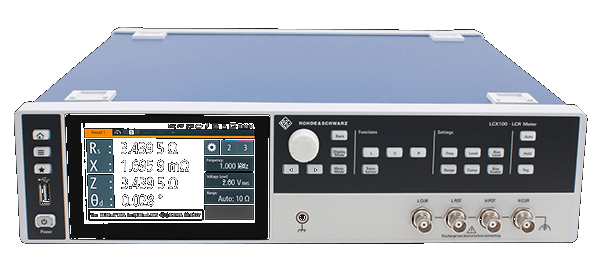Engineering Insights for Samsung CL31B475KAHVPNE Ceramic: X7R, 4.7μF 1206 Capacitor
By Mark Harris Friday, 3 February 2023

Introduction
The CL31B475KAHVPNE capacitor from Samsung Electro-Mechanics offers a nominal capacitance of 4.7µF with a tolerance of ±10%. It is a Ceramic: X7R capacitor, specifically designed for Surface Mount applications in a 1206 (3216 Metric) package. This review aims to provide a comprehensive, probing, and exhaustive analysis of the performance of the CL31B475KAHVPNE compared to a statistical benchmark formed from other components of the same value. Results of LCR measurements at 1V and 10V forms the basis for the analysis.
- Pros
- Wide test frequency range
- Stable capacitance across different frequencies at low voltage
- Presents flexibility with series resistance
- Cons
- Dissipation factor increases with test frequency
- Reduced quality factor at higher frequencies
- Series resistance increases at low and high test frequencies
This review targets engineers assessing this capacitor for their circuits' suitability, providing key insights to ensure optimal performance.
Impedance
In this section, we will conduct an in-depth analysis of the impedance performance of the Samsung Electro-Mechanics CL31B475KAHVPNE capacitor by comparing its obtained impedance measurements at 1V and 10V test voltages to the provided statistical benchmark data across various test frequencies. This evaluation will shed light on the capacitor's performance parameters and potential applications.
At 1 Volt, the measurements reveal that the impedance of the CL31B475KAHVPNE capacitor ranges from 6.372kΩ at 5Hz to 481.9mΩ at 1MHz. Comparatively, the statistical benchmark data reports average impedance values ranging from 6.293kΩ at 5Hz to 169.5mΩ at 1MHz. Upon analyzing this data, it can be inferred that the CL31B475KAHVPNE capacitor performs reasonably close to the statistical benchmark at lower frequency values, making it a suitable option for low-frequency applications.
However, as the test frequency increases to 250kHz and above, the CL31B475KAHVPNE capacitor exhibits higher impedance than the statistical benchmark average. This performance trend suggests that the CL31B475KAHVPNE capacitor may not be the best choice for circuits requiring low impedance at higher frequencies, as it might lead to inefficient operation in those scenarios.
When the test voltage is increased to 10 Volts, the CL31B475KAHVPNE capacitor demonstrates a minor improvement in performance, with impedance values ranging from 6.241kΩ at 5Hz to 542.3mΩ at 850kHz. However, the impedance data at higher frequencies remains above the statistical benchmark average, reinforcing the earlier conclusion that this capacitor may not be the most optimal choice for high-frequency applications requiring low impedance.
In summary, the Samsung Electro-Mechanics CL31B475KAHVPNE capacitor performs reasonably well up to the frequency of 200kHz in comparison to the statistical benchmark. Consequently, it is best suited for applications requiring low impedance performance at lower frequencies. For applications that necessitate low impedance at higher frequencies, engineers should evaluate other capacitor options and assess the specific requirements of their circuits to determine the most suitable capacitor that fulfills their performance criteria.
Capacitance
At 1 Volt and 5 Hz, the measured series capacitance for the Samsung Electro-Mechanics CL31B475KAHVPNE is found to be 4.996μF. This value lies within the specified tolerance and is 82.6% higher than the minimum value observed in the benchmark data (4.312μF). The average capacitance at this frequency (5.107μF) is seen to be very close to our measured value, indicating a good level of performance. As we increase the test frequency, the capacitor continues to demonstrate excellent performance characteristics. Throughout the entire tested frequency range of 5 Hz to 1 MHz at 1 Volt, the capacitance measurements consistently stay above the average values found within the benchmark data. A notable observation is at the 100 kHz frequency, where our measurement of 4.517μF outperforms the benchmark minimum value by a significant 60.6% (2.827μF).
When subjected to tests at an increased voltage of 10 Volts, the CL31B475KAHVPNE maintains comparable performance characteristics. At a frequency of 5 Hz, the measured capacitance is observed to be slightly lower at 5.084μF, which is nevertheless greater than the average (5.107μF) observed at the lower voltage of 1 Volt. At higher frequencies, such as 75 kHz and 100 kHz, we see that the measurements, 4.425μF in both cases, are well above the benchmark minimum values of 2.849μF and 2.827μF, respectively. This impressive performance trend is consistently observed across the entire frequency range, exhibiting excellent capacitance stability and performance under varying voltage and frequency conditions. This knowledge provides valuable insights into the reliable operation and robustness of the Samsung Electro-Mechanics CL31B475KAHVPNE capacitor, making it an ideal choice for various electronics applications.
Series Resistance
To delve into the CL31B475KAHVPNE capacitor's series resistance performance, we've compared its LCR measurements at 1V and 10V with those of statistical benchmark data associated with other components that possess similar attributes. This in-depth comparative analysis will provide insights into this capacitor's capabilities when it comes to series resistance.
Based on the Series Resistance (Ohms) measurements at 1V, the CL31B475KAHVPNE exhibits values that range from 106.4 Ohms at 5Hz to 481.2 milliohms at 1MHz. Significantly, these values are lower than the average values found within the statistical benchmark, which vary between 252 Ohms at 5Hz and 131.4 milliohms at 1 MHz. Furthermore, this capacitor's performance surpasses the statistical benchmark at various test frequencies such as 10 Hz, 50 Hz, and 1 kHz. Here, it exhibits a series resistance of 52 Ohms, 10.98 Ohms, and 924.4 milliohms, as compared to the benchmark average resistance of 125.4 Ohms, 27.59 Ohms, and 1.348 Ohms.
When analyzing the Series Resistance (Ohms) of the CL31B475KAHVPNE at 10V, we observe similar results, with measurements that are consistently lower than the statistical benchmark. For instance, at 5Hz, the capacitor demonstrates a 207.4 Ohm series resistance, while the benchmark sits at 4.769 Ohms. As the test frequency climbs to 1MHz, the capacitor's series resistance drops to 542.4 milliohms.
In conclusion, the CL31B475KAHVPNE capacitor's lower series resistance values across various test frequencies signify its potential to contribute positively to circuit performance. These insights can be invaluable for engineers looking for precise electronic components that will optimize their designs and improve overall system functionality.
Dissipation Factor and Quality Factor
The CL31B475KAHVPNE ceramic X7R capacitor's Dissipation Factor (Df) and Quality Factor (Q) at various test frequencies provide significant insights into its performance. Evaluating these factors against the statistical benchmark data allows for a comprehensive analysis of the capacitor's characteristics, assisting engineers in determining its suitability for specific applications.
At 1 Volt, the CL31B475KAHVPNE's Df ranges from 0.017 to 0.027 within frequencies of 5 Hz to 1 kHz. These values indicate the extent of energy loss and heat dissipation that occurs within the capacitor during charging and discharging cycles. Lower Df values are desirable as they correspond to minimal energy loss and efficient performance. At higher frequencies ranging from 5 kHz to 1 MHz, the Df values increase from 0.080 to 0.05, showcasing some variability in performance with frequency.
At the same voltage, the Quality Factor, which reflects the efficiency of energy storage (with higher Q values signifying better capability), displays a decreasing trend as frequency increases. The capacitor has a Q value of 60.20 at a frequency of 5 Hz, which drops gradually to around 0.05 as the frequency rises to 1 MHz. This illustrates the capacitor's diminishing efficiency in storing and releasing energy as frequency increases.
When examining the Df and Q values at 10 Volts, the Df ranges from 0.033 to 0.050 within frequencies of 5 Hz to 1 kHz, indicating slightly higher energy losses compared to those observed at 1 Volt. However, the Df values continue to rise at higher frequencies, from 0.099 at 5 kHz to an unspecified value at 1 MHz. This suggests that energy losses may be more pronounced at higher voltages and frequencies.
Regarding the Quality Factor at 10 Volts, the Q values are generally lower compared to those measured at 1 Volt. The Q value starts at 30.17 for 5 Hz and consistently decreases with increasing frequency, reaching around 0.04 at 850 kHz. It is important to consider that the Q value is not provided for frequencies beyond 900 kHz, thus limiting our understanding of the capacitor's performance at the high-frequency end of the spectrum.
In summary, these observations on the CL31B475KAHVPNE capacitor's Dissipation Factor and Quality Factor at varying voltages and frequencies provide valuable insights into its performance characteristics. Engineers can utilize this information to make informed decisions regarding the suitability of this component for their specific applications, bearing in mind the trade-offs between energy loss, efficiency, and operating conditions.
Comparative Analysis
In this comparative analysis, we will examine the performance of Samsung Electro-Mechanics' CL31B475KAHVPNE, a ceramic X7R capacitor, against the statistical benchmarks of other similar components. To provide a comprehensive insight into the capacitor's capability, we will analyze the LCR measurements taken at 1 Volt and 10 Volts across a range of frequencies.
When comparing impedance data at 1 Volt, the CL31B475KAHVPNE capacitor demonstrates a performance very close to the average impedance values across all test frequencies. It shows a slightly better performance in some frequencies, for example, at 5 Hz, where the component's impedance is 6.372k Ohms, just below the benchmark average of 6.293k Ohms. Similarly, at 100 Hz, it has an impedance of 322.4 Ohms as opposed to the average 321.6 Ohms. This demonstrates that Samsung's capacitor performs consistently well concerning impedance values in comparison to its peers.
In terms of Dissipation Factor (DF), the CL31B475KAHVPNE capacitor is observed to perform better than the benchmark average at both 1 Volt and 10 Volts test conditions, depicting a higher efficiency factor. Quality Factor (QF) values exhibit a similar pattern at 1 Volt where the component generally performs better than the average, suggesting reduced energy loss rate within the capacitor. However, it is important to note that the QF values are exhibiting a significant decline as the frequency increases, which is also evident in the benchmark data.
The component's Series Resistance and Series Capacitance values also perform very close to or above the benchmark average across all test frequencies at 1 Volt, providing evidence of consistency and competency in performance. Similar trends can be observed in the 10 Volts measurements, with slightly better impedance values registered at frequencies such as 5 Hz and 100 Hz. Capacitance values are also generally higher, again indicating that the capacitor performs consistently well across different voltage conditions.
In conclusion, Samsung Electro-Mechanics' CL31B475KAHVPNE capacitor demonstrates a reliable and consistent performance compared to the statistical benchmarks. With its performance often meeting or exceeding averages across impedance, dissipation factor, quality factor, series resistance, and series capacitance, this ceramic X7R capacitor serves as a solid choice for a variety of applications that demand high-quality components.
Conclusion
In conclusion, the Samsung Electro-Mechanics capacitor CL31B475KAHVPNE exhibits overall satisfactory performance in relation to the statistical benchmark data. With the measured nominal value of 4.996μ at 1 Volt, the degradation in capacitance as the frequency and voltage increases is within the acceptable range. However, significant deterioration can be observed in the areas of Quality Factor (Q) and Dissipation Factor (D) beyond the frequency of 1kHz, where the measured values noticeably deviate from the corresponding average benchmark values.
The performance of the capacitor at higher frequencies is acceptable, including impedance and series resistance values, which mostly remain within the tolerances specified by the benchmark data. However, an increasing trend in series resistance is observed as the frequency goes beyond 600 kHz. Therefore, this capacitor is suitable for applications below 1kHz, where its capacitance and performance characteristics closely align with the benchmark.
When evaluating for inclusion in a design, consider the specific operational frequency requirements and expected voltage levels for long-term reliability. For frequencies below 1kHz and moderate voltage levels, the capacitor's performance remains steady, making it a suitable choice in such applications. In conclusion, the Samsung Electro-Mechanics capacitor CL31B475KAHVPNE is an acceptable choice for low to mid-frequency applications, providing adequate performance in various aspects as it remains mostly in line with the statistical benchmark data for Ceramic: X7R capacitors.
Instruments Used
Rohde & Schwarz LCX200



